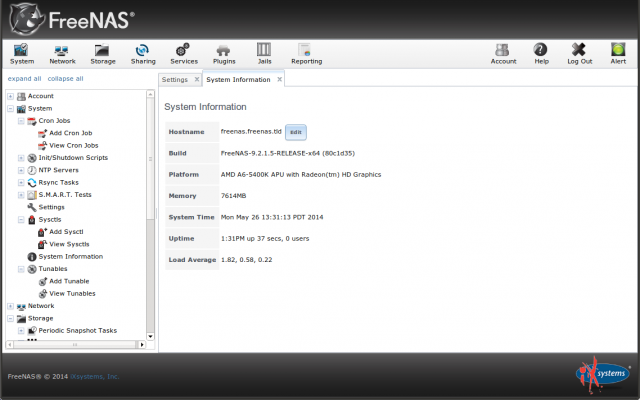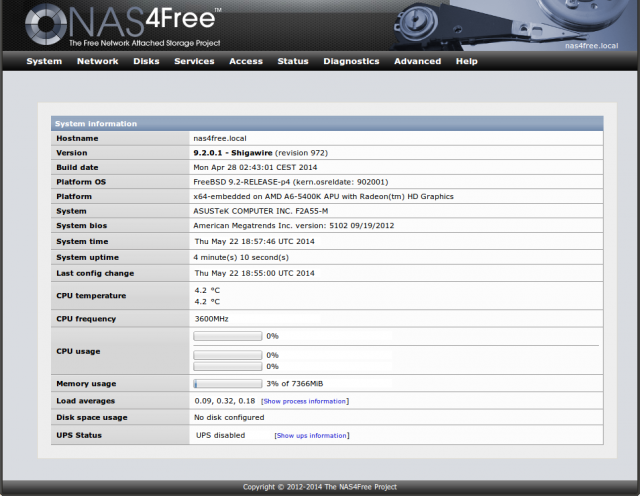
If you've been following along with our earlier articles on next-gen filesystems like btrfs and zfs, but wanted an easy way to get started without having to learn anything on the command line (or need an easy way to take advantage even though you're a Windows-only user), you're in luck. Today, we're going to look at two ready-to-rock ZFS-enabled network attached storage distributions: FreeNAS and NAS4Free. 

What's in a name?
If FreeNAS and NAS4Free sound suspiciously similar, it's because they share a common root. Both are descended from the original FreeNAS code, founded by Olivier Cochard-Labbé in 2005. In 2009, the development teams began shifting away from ZFS and toward an extensible plugin architecture, which they believed would be easier to implement in Linux. This caused considerable unrest among the existing userbase, prompting the project lead to depart for more penguin-y pastures.
ixSystems—the same folks who maintain the PC-BSD desktop oriented flavor of FreeBSD—acquired the FreeNAS name from Mr. Cochard-Labbé in 2011. They rewrote it with a new architecture based on a newer Web platform (django) and a newer version of FreeBSD. Not all users were happy with the new architecture, however, which led in 2012 to the NAS4Free project abandoning ixSystems' work and, in their own words, continuing directly from the original codebase.
What they have in common
FreeNAS and NAS4Free are both "turnkey" network attached storage distributions with a relatively simple setup and Web interface for easier management. They each tie a lot of underlying technology together for the ease of the user: ZFS, FTP, CIFS/SMB (Windows networking), AFP (Mac networking, necessary if your NAS is going to be a Time Machine backup target), NFS, iSCSI, and more.
They're also both designed to be installed directly to a thumb drive on the premise that the NAS system itself is relatively simple and unimportant, whereas maximizing the number of hard drives and the amount of storage available for user data is all-important. Most users are probably going to use the Windows networking feature more heavily than anything else, and both distributions are well equipped to support that.
Each can handle either standalone authentication (create usernames and passwords on the NAS and use matching ones on the PCs on the network) or Active Directory integration (join a Windows domain and use centralized usernames and passwords from the domain). They support full Windows ACL (access control list) permissions as well as native Unix owner/group/world style modes and ownership.
Windows users can successfully view and edit ownership and permissions using Windows Explorer without realizing anything is amiss. Both distributions even support exposing ZFS snapshots as Volume Shadow Copies to Windows clients, which means that Windows users can just right-click a share (or an individual file or folder for FreeNAS) and select "Restore Previous Versions" to have it Just Work.
Where they diverge
In a nutshell, ixSystems' FreeNAS 9.2.1 attempts to realize the goals of both the original and later FreeNAS dev teams—a solid, usable Web interface for an embedded NAS and a highly extensible plugin system to add to its capabilities. ixSystems has put a lot of work into a ground-up rewrite of the Web interface with more modern tools (the original FreeNAS, and now NAS4Free, uses a modified version of m0n0wall's Web interface).
The plus side of this is what you'd expect: plugins and snazziness. (It might also mean easier code maintenance, but that's just a wild guess.) The minus side is that the new interface is significantly clunkier to figure out and navigate than NAS4Free's older m0n0wall-based interface.
FreeNAS also tends to be noticeably bleeding-edge, which may delight you as a technical enthusiast or quietly horrify you as a more conservative sort of techie. By contrast, NAS4Free dispenses with the fancy stuff and sticks with a more down-to-earth and focused "I am a NAS and I am good at it" game plan. You don't get newsgroup readers or bittorrent clients or owncloud servers, and you can't make your own domain controller with it, but NAS4Free has a much cleaner, more usable interface. It readily exposes more of the information you actually need without cluttering things up with glitz that you don't. In my opinion, NAS4Free's Web interface tends to just feel more solid and reliable. But enough with the high-altitude overview, let's dive down into the weeds a bit, shall we?
reader comments
263